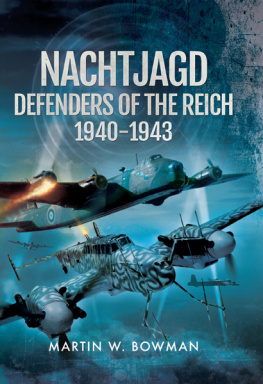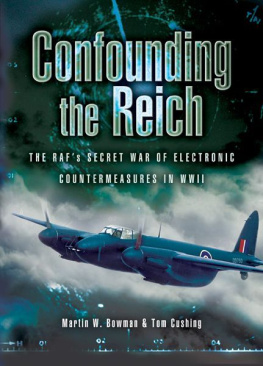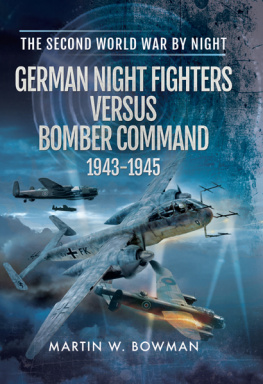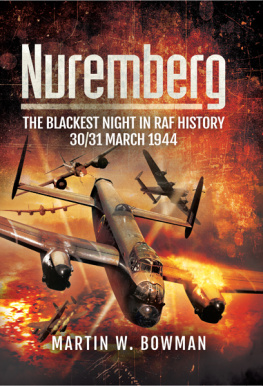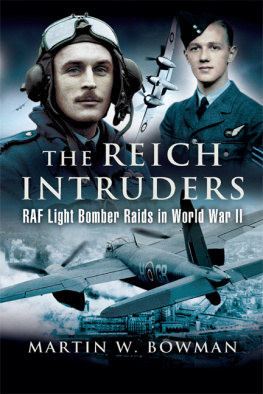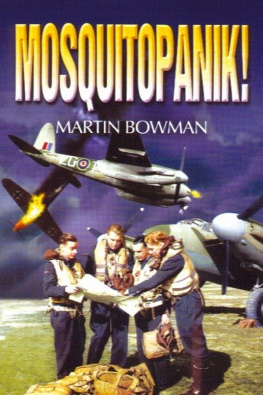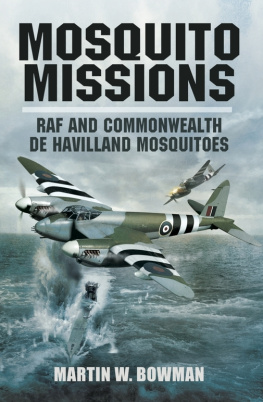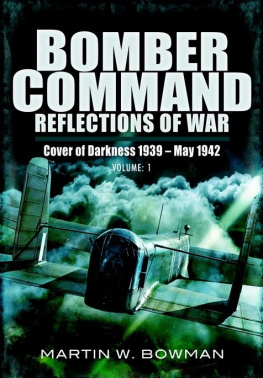Bowman - Nachtjagd, Defenders of the Reich 1940-1943
Here you can read online Bowman - Nachtjagd, Defenders of the Reich 1940-1943 full text of the book (entire story) in english for free. Download pdf and epub, get meaning, cover and reviews about this ebook. City: Germany, year: 2016, publisher: Pen & Sword Aviation, genre: Non-fiction. Description of the work, (preface) as well as reviews are available. Best literature library LitArk.com created for fans of good reading and offers a wide selection of genres:
Romance novel
Science fiction
Adventure
Detective
Science
History
Home and family
Prose
Art
Politics
Computer
Non-fiction
Religion
Business
Children
Humor
Choose a favorite category and find really read worthwhile books. Enjoy immersion in the world of imagination, feel the emotions of the characters or learn something new for yourself, make an fascinating discovery.
- Book:Nachtjagd, Defenders of the Reich 1940-1943
- Author:
- Publisher:Pen & Sword Aviation
- Genre:
- Year:2016
- City:Germany
- Rating:5 / 5
- Favourites:Add to favourites
- Your mark:
- 100
- 1
- 2
- 3
- 4
- 5
Nachtjagd, Defenders of the Reich 1940-1943: summary, description and annotation
We offer to read an annotation, description, summary or preface (depends on what the author of the book "Nachtjagd, Defenders of the Reich 1940-1943" wrote himself). If you haven't found the necessary information about the book — write in the comments, we will try to find it.
Nachtjagd, Defenders of the Reich 1940-1943 — read online for free the complete book (whole text) full work
Below is the text of the book, divided by pages. System saving the place of the last page read, allows you to conveniently read the book "Nachtjagd, Defenders of the Reich 1940-1943" online for free, without having to search again every time where you left off. Put a bookmark, and you can go to the page where you finished reading at any time.
Font size:
Interval:
Bookmark:
First Published in Great Britain in 2016 by
Pen & Sword Aviation
an imprint of
Pen & Sword Books Ltd
47 Church Street, Barnsley, South Yorkshire S70 2AS
Copyright Martin W Bowman, 2015
ISBN: 9781473849839
PDF ISBN: 9781473849860
EPUB ISBN: 9781473849846
PRC ISBN: 9781473849853
The right of Martin W Bowman to be identified as author of this work has been asserted by him in accordance with the Copyright, Designs and Patents Act 1988.
A CIP catalogue record for this book is
available from the British Library.
All rights reserved. No part of this book may be reproduced or transmitted in any form or by any means, electronic or mechanical including photocopying, recording or by any information storage and retrieval system, without permission from the Publisher in writing.
Typeset in 10/12pt Palatino
by GMS Enterprises PE3 8QQ
Printed and bound in England by
CPI Group (UK) Ltd, Croydon, CR0 4YY
Pen & Sword Books Ltd incorporates the Imprints of Pen & Sword Aviation, Pen & Sword Family History, Pen & Sword Maritime, Pen & Sword Military, Pen & Sword Discovery, Wharncliffe Local History, Wharncliffe True Crime, Wharncliffe Transport, Pen & Sword Select, Pen & Sword Military Classics, Leo Cooper, The Praetorian Press, Remember When, Seaforth Publishing and Frontline Publishing.
For a complete list of Pen & Sword titles please contact
PEN & SWORD BOOKS LIMITED
47 Church Street, Barnsley, South Yorkshire, S70 2AS, England
E-mail:
Website: www.pen-and-sword.co.uk
Contents
Acknowledgements
I am indebted to all the contributors for their words and photographs, in particular Nora Norgate; Jim Moore DFC and The 49 Squadron Association. I am equally grateful to Theo Boiten for information, images and invaluable reference work. And to everyone connected with the Kracker Archive, Simon Parry and John Foreman.
Thanks also go to my fellow author, friend and colleague, Graham Simons, for getting the book to press ready standard and for his detailed work on the photographs; to Pen & Sword and in particular, Laura Hirst; and Jon Wilkinson, for his unique jacket design once again.
Pauke! Pauke! (Kettledrums! Kettledrums!): the Leutnant had obtained visual contact of his target. It was a Lanki, crossing gently from port to starboard. His bordfunker immediately transmitted Ich beruhe. Then they closed in rapidly for the kill - 300, 200, 150 metres, finally opening fire from 100 metres.
Strikes peppered the fuselage and danced along the wing root. Another two-second burst and the four-engined bomber burst into flames. Doomed, it fell away to port in a flaming death dive, impacting in a German forest. Gouts of fuel from ruptured tanks ignited and lit up the night sky with a reddish hue. The engines buried themselves deep into the earth. Sieg Heil! said the pilot over R/T to ground control. The British bomber crew had unwitting been homed in on: its H2S set had been picked up by the night-fighters Naxos Z FuG 250, while Flensburg FuG 227/1 homed in on the bombers Monica tail-warning device.
On another night it would be the turn of the Leutnant and his Unteroffizier to be the preyed-upon. It was all part of a deadly and sophisticated electronic game in which the RAF, the Luftwaffe, aided by the scientists, pitted their wits in an ethereal, nocturnal battleground. One side gained the ascendancy until the inevitable counter-measure was found.
Confounding the Reich: The Operational History of 100 Group (Bomber Support) RAF.
Chapter One
Night Fighting! It Will Never Come To That!
Josef Kammhuber was born in Tssling, Bavaria on 19 August 1896, the son of a farmer. At the beginning of World War I he was 18 and joined a Bavarian engineer battalion. He experienced the Battle of Verdun in 1916 and was promoted to Leutnant in 1917. He was allowed to remain in Germans tiny post-war army and in 1925 was promoted to Oberleutnant. Between October 1926 and September 1928, he received division-level leadership training. From 1 May to 30 September 1930 he was sent to the USSR for secret pilot training. On his return he joined the staff of General Walter Wever, chief of staff of the Luftwaffe. He was promoted to Hauptmann on 1 February 1931. Wever was in the process of attempting to set up a strategic bomber command but in June 1936 Wever was killed in an air crash. Kammhuber had continued to rise in the ranks, promoted to Major on 1 October 1934, Oberstleutnant on 1 October 1936 and then Oberst on 1 January 1939. Kammhuber had put in a request in February 1939 for active duty. Promoted to Generalmajor, he was assigned as chief-of-staff of Luftflotte 2 and was in this position at the start of the war in September. In January 1940 he was transferred to the Western Front where he became Geschwader-Kommodore of KG51, a tactical bomber unit. During the French campaign he was shot down and captured and interned in a French PoW camp at the age of 44. He was released at the end of the Battle of France in July 1940 and returned to Germany where he was placed in command of coordinating flak, searchlight and radar units. At the time these were all under separate command and had no single reporting chain; so much of the experience of the different units was not being shared. The result was XII Fliegerkorps, a new dedicated night-fighting command.
Patrick Foss was born in Ketton, Rutland on 8 November 1913. When he was about nine years old he decided he wanted to go to sea in the Merchant Navy. He searched a reference book of schools and found the Nautical College, Pangebourne. His mother, who ran the Linden Hall Hotel in Bournemouth, agreed that she would send him there when he was thirteen. At the end of his first year, aged fourteen, he spent his summer vacation signing on a tramp steamer on the run from Cardiff to Oporto in Portugal as a shilling a month steward. He slept late and ate in the officers quarters, but did any work that needed doing, from scraping paint to taking a turn at the steering wheel. When he was seasick the Captain sent him down to the engine room where he was put to work greasing the steel piston rods as they reciprocated out of the cylinders. It was at that point in the ship where the movements were minimal. A year later Foss signed on for another trip with his brother Denis, this time from Barry Docks in South Wales to Nantes on the River Loire in France, conveying coal dust to a power station. Returning to Barry Docks he glimpsed dimly the dimension of the vast unemployment gripping Britain. These were the early days of the Great Depression and something like two million were registered unemployed. Then and there he decided that for an ambitious lad like him the sea was not his profession. His thoughts turned to the sky.
While he waited for work at Saunders Roe, which had no work, Foss worked at a garage near the Linden Hall Hotel, pumping petrol into the customers cars. He ground in valves and helped skilled men work on jobs and learned a great deal. He felt sure that he was headed on his chosen road of aviation. Then came the next step along the aviation path. A young aviation engineer visited the hotel. He told Foss that if he wanted to learn to fly, the most inexpensive way was to go to Germany where he could get cheap flying instruction, especially on gliders, because of the high rate of exchange of the Travellers Mark. Foss at once booked the first course in the spring of 1931 on the Wasserkuppe in Bavaria. Germany led the world in the art of gliding. This was no accident. Under the Versailles Treaty, following World War One, Germany was forbidden to train military pilots and so men who looked ahead to the building an air force used gliding to create a reservoir of men skilled in the basics of flying.
After a long rail journey down the Rhine and into the hinterland Foss reached the mountain, Wasserkuppe, upon which the gliding school stood. He found a number of German youth milling around the station and they clubbed together to hire a taxi. The school consisted of long, low army huts, divided into small rooms sleeping two each. Other huts were a dining room, cook house and workshops, with hangars alongside. The whole place was under several feet of snow and a blanket of fog. There was no possibility of gliding. They were given some ground instruction and sat around and filled the day as best they could. Foss found two Britishers on the course, one a dance band drummer in his mid-thirties and the other a student aged twenty-one.
Next pageFont size:
Interval:
Bookmark:
Similar books «Nachtjagd, Defenders of the Reich 1940-1943»
Look at similar books to Nachtjagd, Defenders of the Reich 1940-1943. We have selected literature similar in name and meaning in the hope of providing readers with more options to find new, interesting, not yet read works.
Discussion, reviews of the book Nachtjagd, Defenders of the Reich 1940-1943 and just readers' own opinions. Leave your comments, write what you think about the work, its meaning or the main characters. Specify what exactly you liked and what you didn't like, and why you think so.

